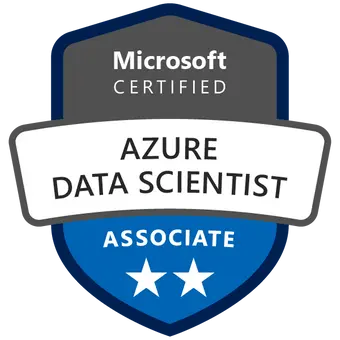Få nye IT kompetencer, bliv certificeret og løft din IT-karriere til nye højder uden at sprænge banken!
Unlimited Training - IT Kurser og Certificeringer gjort helt enkelt og utroligt billigt. Få adgang til 60+ Top LIVE kurser for mindre end prisen for ét kursus.











course: Microsoft Certified Azure Data Scientist (DP-100)
Varighed: 4 days
Format: Virtual or Classroom


Introduktion
Lås op for kraften ved dataanalyse med vores specialiserede træningskursus. Lær at visualisere og analysere data ved hjælp af Microsoft Power BI. Fra datamodellering til rapportskrivning dækker dette kursus alle aspekter af Power BI-dataanalyse. Med praktiske laboratorier og ekspertledet instruktion får du de nødvendige færdigheder til at bestå DA-100-eksamenen og blive certificeret som Microsoft Certified Power BI Data Analyst. Tilmeld dig nu og bliv en dygtig dataanalytiker med vores omfattende trænings- og certificeringskursus.
 Instruktørledet træning
Instruktørledet træning Practice test
Practice test Selvstudie materiale
Selvstudie materiale Personlig læringsplan
Personlig læringsplan Certificeringsgaranti
Certificeringsgaranti E-mail, chat og telefonsupport
E-mail, chat og telefonsupport









Hvem henvender kurset sig til?
Microsoft Certified Azure Data Scientist (DP-100)-certificeringen er beregnet til dem, der ønsker at demonstrere deres færdigheder i at skabe og implementere machine learning-modeller på Azure. Denne certificering er ideel til datavidenskabsfolk, dataingeniører og andre tekniske fagfolk, der er interesseret i at bruge Azure-tjenester til at udvikle, træne og implementere maskinlæringsmodeller. DP-100 certificeringseksamenen dækker emnersåsom maskinlæringsprocessen og datavidenskab, dataforberedelse til maskinlæring, udvikling af maskinlæringsmodeller, træning og optimering samt udrulning af maskinlæringsmodeller på Azure.
Kursusindhold
Forberedelse
Hos Readynez stiller vi mange ressourcer til rådighed og har erfarne eksperter på området. Derfor har vi også stor succes med mange tilfredse kunder. Du kan derfor trygt tage dit kursus hos os. For at tage DP-100 kurset kræves dog nogle forudsætninger.
Du har det perfekte udgangspunkt for at tage dette kursus med disse forudsætninger:
Mød nogle af de instruktører du kan møde på dit kursus. De er eksperter, passionerede omkring deres fag og dedikerede til at give deres viden tilbage til branchen, deres fag og dem som ønsker at lære, udforske og skabe fremskridt i deres karriere.

Ed er en mangeårig MVP og har udviklet flere officielle Microsoft kurser for Azure, Windows Server og Windows.
Ed has been with Readynez almost since the start 12 years ago.
He is a 25 year IT veteran with experience in the UK Police and armed forces. Ed is a former Microsoft Technical Evangelist and is an MCT Regional Lead for the UK and he currently holds the most prestigious Microsoft MVP accreditation. Ed also helps run the UK MS Cloud User Group and the annual Evolve Conference in the UK.
Ed has authored several Microsoft Official Curriculum Courses for Azure, Windows Server and Windows as well as writing courses for Opsgility and other online providers.
Ed is a regular conference speaker at events such as TechEd, Ignite, TechSummit, SpiceWorld and more.
Ed now spends his time mixed between teaching Microsoft Azure, Windows Server and Enterprise Mobility topics. In addition Ed provides consultancy services to Small and Medium Enterprises as well as direct to Microsoft UK and Microsoft Corp.

Tiago Costa er Microsoft MVP, Cloud Architect samt Advisor og international taler om Microsoft Cloud.
Tiago is a Microsoft MVP ( Most Valuable Professional)
Tiago Costa is a Cloud Architect and Advisor for the Microsoft Azure. For the past years he has been helping customers migrating to the cloud and creating cloud native workloads.
Biography
Tiago Costa is a Cloud Architect and Advisor and International speaker for the Microsoft Cloud. For the past years he has been architecting and developing solutions using Microsoft Azure for some of the fortune 500 companies. Due to his strong real-world experience, Tiago regularly teaches Microsoft Azure classes around the world. Microsoft Azure MVP since 2016 for his community efforts in promoting and sharing knowledge with the community.
Tiago has 40+ Microsoft Certifications including MCT – Microsoft Certified Trainer and got awarded as MCT Regional Lead since 2016 every year. He’s the founder of the Azure Portugal User Group. He loves diving into new technologies and to share his experience at conferences and training classes, but what excites him about his work is to help others exploring new frontiers in technology impacting their life’s, making the world a better place for everyone. His free time is spent with his family in the sunny Lisbon, Portugal building cool and geek projects
FAQ
DP-100 Azure Data Scientist-certificering validerer ekspertise i at designe og implementere machine learning-modeller og -løsninger ved hjælp af Azure Machine LearningDet dækker forskellige aspekter af datavidenskab, herunder dataforberedelse, feature engineering, modeltræning og -evaluering og udrulning og forbereder fagfolk til roller inden for datavidenskab og maskinlæringsteknik.
Vores DP-100 Azure Data Scientist-kursus forbereder dig til at udmærke dig i datavidenskabsroller på AzureForbered dig til eksamen og opnå certificering som Azure Data Scientist med vores ekspertledede træningsprogramLær at bygge og implementere maskinlæringsmodeller og udvinde værdidygtige indsigter fra dataSlut dig til os og bliv en dygtig dataforsker i skyen.
Selvom der ikke er nogen strenge forudsætninger for DP-100 Azure Data Scientist-certificering, bør kandidater have en stærk forståelse af datavidenskabskoncepter, erfaring med at arbejde med maskinlæringsalgoritmer og rammer og færdigheder i programmeringssprog såsom PythonKendskab til Azure-tjenester og cloud computing er en fordel til eksamensforberedelse.
Prisen for DP-100-eksamenen er omkring €142.
DP-100-eksamenen dækker emner som dataforberedelse, funktionsudvikling, modeltræning og -evaluering og modelimplementering ved hjælp af Azure Machine LearningDen vurderer kandidaternes evner til at designe og implementere maskinlæringsløsninger effektivt ved hjælp af Azure-tjenester.
Ja, DP-100 Azure Data Scientist-certificering er yderst værdifuld for fagfolk, der forfølger karrierer inden for datavidenskab, maskinlæring og kunstig intelligens ved hjælp af Azure-teknologierDet demonstrerer ekspertise i at designe og implementere maskinlæringsmodeller og -løsninger, forbedre karrieremuligheder og indtjeningspotentiale på området.
Den tid, det tager at blive DP-100 Azure Data Scientist-certificeret, varierer afhængigt af individuel erfaring, studievaner og forberedelsesmetoderKandidater bruger typisk flere uger til et par måneder på at forberede sig til eksamen gennem selvstudium, træningskurser og praktisk praksis for at opbygge den nødvendige viden og færdigheder.
Ja, Microsoft tilbyder online-proctorerede muligheder for DP-100-eksamenen, hvilket giver kandidater mulighed for at tage eksamenen eksternt fra deres hjem eller kontorSørg for, at din computer opfylder de tekniske krav til online proctoring, og følg den eksamensregistreringsproces, der er skitseret af Microsoft for online eksamenslevering.
Sværhedsgraden ved at bestå DP-100 eksamen afhænger af individuel viden, erfaring og forberedelseKandidater med en solid forståelse af datavidenskabsprincipper, praktisk erfaring med Azure Machine Learning og grundig eksamensforberedelse er mere tilbøjelige til at lykkes med at bestå eksamen.
Beståelsesscore for DP-100 eksamen er typisk omkring 700 ud af 1000.
For at opretholde DP-100 Azure Data Scientist-certificering skal certificerede fagfolk forny deres certificering med jævne mellemrum ved at bestå en fornyelseseksamen eller gennemføre relevante efteruddannelsesaktiviteterHold dig opdateret med den seneste udvikling inden for datavidenskab og maskinlæring, deltag i avancerede træningskurser, og deltag i løbende læring for at bevare din certificeringsstatus.
Lønpotentiale for DP-100 Azure Data Scientist-certificerede fagfolk varierer baseret på faktorer som placering, erfaring, branche og jobrolleDataforskere og maskinlæringsingeniører med ekspertise i Azure Machine Learning og datavidenskabsteknikker har typisk konkurrencedygtige lønninger, hvor indtjeningspotentialet stiger med yderligere erfaring og specialisering på området.
Anmeldelser

Readynez er den bedste træningsudbyder, jeg har brugt i mange år. Deres kundeservice er førsteklasses, priserne er meget konkurrencedygtige og instruktørerne er fremragende.

Nemt at deltage på kurset over Teams og en fremragende instruktør gav mig stor værdi for den tid, jeg investerede.
Hvorfor Betale Mere?
Hvorfor nøjes med bare ét certificeringskursus når du kan deltage på ALLE certificeringskurser for en pris der er lavere end prisen for ét kursus?

Den perfekte måde for os til at udvikle de kompetencer vi behøver for succes
![]() Kasper Meyer Christensen
Kasper Meyer Christensen
Virksomheder der udnytter Unlimited Training sparer mindst 50% på deres træning og certificeringer - og mange helt op til 80%
Folk med en Unlimited Training licens gennemfører i gennemsnit 2,4 kurser pr år

For en pris der er mindre end prisen for ét kursus.

Bare billigere og mere fleksibelt.

Den nemmeste, mest fleksible og billigste måde at blive certificeret på.

Deltag på så mange kurser som du vil - ingen begrænsninger!

Vi tilbagebetaler hvis omkostningen til licensen overstiger værdien af din træning.

Interager 1-til-1 med 50+ erfarne instruktører.

